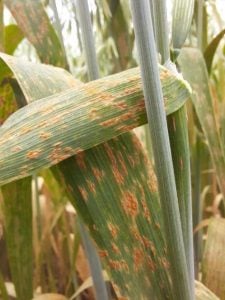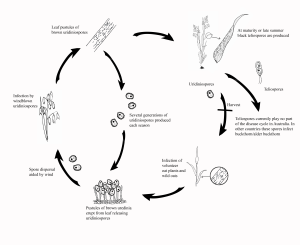Oat Crown rust is caused by Puccinia coronata var. avenae and is also known as Leaf rust. The word ‘crown’ refers to the shape of the spore produced by the fungus but not the description of the symptoms. Oat Crown rust is related to wheat and barley leaf rust but is caused by a different species which does not infect either wheat or barley. Similarly, neither wheat nor barley rusts cause infection in oats. Oat Crown rust, however, is a potentially damaging disease and can reduce both grain and hay yields. Susceptible varieties are more vulnerable to Crown rust and severe losses can be expected.
What to look for
Crown rust produces small round to oblong, orange to yellow pustules on leaves but also on leaf sheath and heads. These pustules when disrupted release powdery masses of spores which infect new plants. The pustule areas may turn black with age.
Disease Cycle
Rust requires live plants to grow and reproduce and cannot be carried over to the next season on seed, stubble or in soil. Crown rust survives on volunteer oats and/or wild oats that grow following summer rains. Plants heavily infected with the rusts become a source of infection for the new season’s oat crop. The epidemic risk is higher during where there is average or greater rainfall during the spring months as optimum temperatures for rust infection are 15-22°C.
Economic Importance
Oat Crown rust can be a very damaging disease that reduces grain yield by up to 20 per cent and reduce grain quality. Losses to biomass and feed quality have also been reported in forage crops.
Management
Cultural Practices
Green bridge management is important during summer and autumn for rust control. Heavy grazing or herbicide application to remove volunteer and wild oats reduces rust inoculum carryover to the next season.
Resistant Varieties
The most effective way to control Crown rust is to grow resistant varieties and avoid sowing susceptible to very susceptible varieties. Resistant varieties also reduce the chance of new mutations and occurrence of new pathotypes by minimising the levels of rust in crops. Keep up to date with varieties’ ratings for Crown rust with a current Cereal Disease Guide or the NVT website.
Crown rust can develop new pathotypes which can change a variety’s resistance reaction. Current pathotypes are monitored every season to ensure that resistance ratings are up to date. The Australian Cereal Rust Control Program, based at the University of Sydney along with the Pests and Diseases team at CSIRO, Canberra, conducts annual monitoring of Crown rust pathotypes present in Australia, supported by GRDC. The information on the pathotypes is crucial in determining how varieties will perform against the dominant rusts present in Australia. For details on how to submit Crown rust samples for pathotyping and to view pathotyping results see the Further Information section.
Fungicides
Foliar fungicides are available for the control of Crown rust in oats. The best time to apply foliar fungicides is at the first sign of the rust in the crop. Rust epidemics can develop rapidly, so monitoring crops for traces of rust and application of fungicide immediately after detection is recommended. If the rust severity is high, then there may be a need for two fungicide applications. Late rust epidemics after panicle emergence are less likely to cause a significant yield loss and generally do not benefit from fungicide application.
It is important that growers follow all label directions including rates, crop growth stages and withholding periods to grazing, cutting for forage/hay and harvest to ensure that maximum residue limits are not exceeded in destination markets.
DO NOT apply more than 2 applications of any product(s) from the same mode of action group in any one season. If additional applications are required during periods of high disease pressure, then growers need to switch to alternative products with differing modes of action. To reduce the risk of fungicide resistance development. See Fungicides for further information about fungicide resistance.




